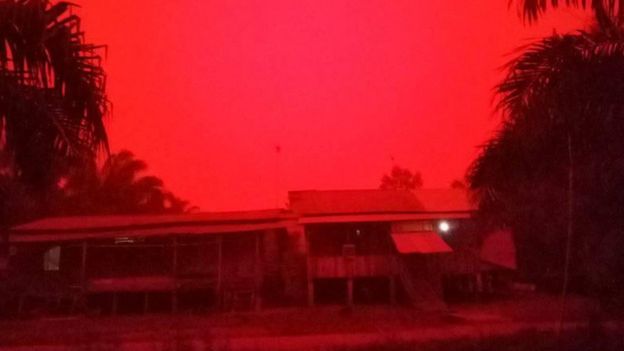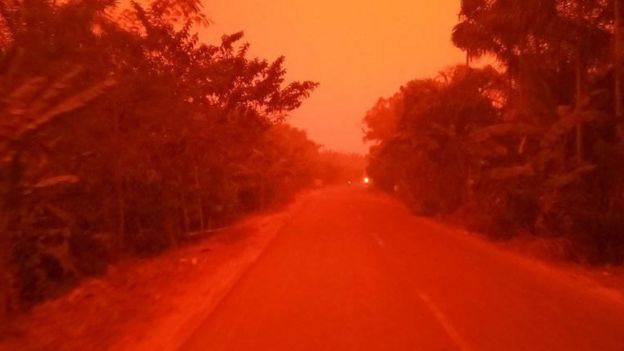Skies over an Indonesian province turned red over the weekend, thanks to the widespread forest fires which have plagued huge parts of the country.
One resident in Jambi province, who captured pictures of the sky, said the haze had "hurt her eyes and throat".
Every year, fires in Indonesia create a smoky haze that can end up blanketing the entire South East Asian region.
A meteorology expert told the BBC the unusual sky was caused by a phenomenon known as Rayleigh scattering.
Eka Wulandari, from the Mekar Sari village in Jambi province, captured the blood-red skies in a series of photos taken at around midday on Saturday.
The haze conditions had been especially "thick that [day]", she said.

The photographer denied claims that the pictures were fake. EKA WULANDARI
The 21-year-old posted the pictures on Facebook. They have since been shared more than 34,000 times.
But she told BBC Indonesian that many online had doubted whether or not the photos were real.
"But it's true. [It's a] real photo and video that I took with my phone," she said, adding that haze conditions remained severe on Monday.

The village of Mekar Sari turned a deep shade of red. EKA WULANDARI
Another Twitter user posted a video showing similarly coloured skies.
"This is not Mars. This is Jambi," said user Zuni Shofi Yatun Nisa. "We humans need clean air, not smoke."
Image Copyright @ZUNISHOFIYN
Indonesia meteorological agency BMKG said satellite imagery revealed numerous hot spots and "thick smoke distribution" in the area around the Jambi region.
Professor Koh Tieh Yong, of the Singapore University of Social Sciences, explained that this phenomenon, known as Rayleigh scattering, has to do with certain types of particles that are present during a period of haze.
"In the smoke haze, the most abundant particles are around 1 micrometre in size, but these particles do not change the colour of the light we see," he told the BBC.
"There are also smaller particles, around 0.05 micrometres or less, that don't make up a lot of the haze but are still somewhat more abundant during a haze period [than a normal non-haze period]... but this is enough to give an extra tendency to scatter red light more in the forward and backward directions than blue light - and that is why would you see more red than blue."
He said the fact the photos were taken around noon could have caused the sky to appear more red.
"If the sun is overhead and you look up, [you will be looking] in the line of the sun, so it would appear that more of the sky is red."
Prof Koh added that this phenomenon would not "modify the air temperature".
This year's haze levels have been some of the worst in years.
The haze is caused by open burning in Indonesia and to a lesser extent, parts of Malaysia. The burning usually peaks from July to October during Indonesia's dry season. According to Indonesia's national disaster agency, some 328,724 hectares of land had already been burnt in the first eight months of the year.
Part of the blame for the haze lies with big corporations and small-scale farmers, which take advantage of the dry conditions to clear vegetation for palm oil, pulp and paper plantations using the slash-and-burn method.
This slash-and-burn technique employed by many in the region is arguably the easiest way for farmers to clear their land and helps them get rid of any disease that may have affected their crops.
However, these fires often spin out of control and spread into protected forested areas.
Slash-and-burn is illegal in Indonesia but has been allowed to continue for years, with some saying corruption and weak governance have contributed to the situation.
Source:
Related to SDG 13: Climate action



